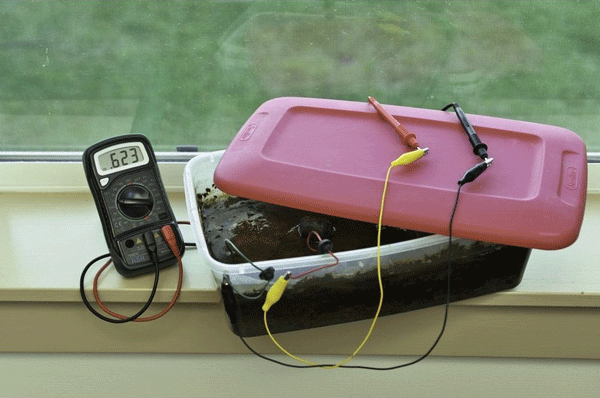
Did you know you can generate electricity from the “metal-breathing” anaerobic bacteria found in ordinary mud? Having no oxygen to breathe, these bacteria produce energy for their growth by transferring electrons to clumps of rust and other metal oxides, in a process called dissimilatory metal reduction. Dr. Ashley Franks, director of K–12 outreach at the Geobacter Project and senior lecturer at Latrobe University, has extensively studied these bacteria, and shared his how-to for creating your own microbial fuel cell to harness this energy on the pages of MAKE Volume 30.
From his intro:
A microbial fuel cell (MFC) does the same thing as a battery: drive electrons from an anode to a cathode through chemical oxidation/reduction reactions. What makes MFCs different is that they run on organic substrate and bacteria.
“Metal-breathing” (Geobacter) bacteria at the anode carry out the oxidation reaction, converting plant and animal debris in the mud into electricity and carbon dioxide. Electrons flow through wires to a cathode sitting in water above the mud, where they combine with oxygen to complete the circuit. The bacteria are highly efficient in this arrangement and can produce electricity continuously for many months or even years.
Experimental MFC-powered buoys now operate in the Potomac River, using naturally occurring bacteria in the mud to measure and transmit meteorological data. These “Benthic Unattended Generators” (BUGs) have worked for several years with no decrease in power output (see http://nrl.navy.mil/code6900/bug). Geobacter species possess other useful abilities, such as the ability to respire radioactive uranium and remove it from ground water. They have proven versatile and effective in cleaning up areas contaminated with uranium or organic pollutants.
Dr. Frank’s full how-to is available for you over on Make: Projects and the Maker Shed even carries the KeegoTech MuddWatt MFC Kit, which includes all the parts you need except for the mud.
From the pages of MAKE Volume 30:

ADVERTISEMENT







